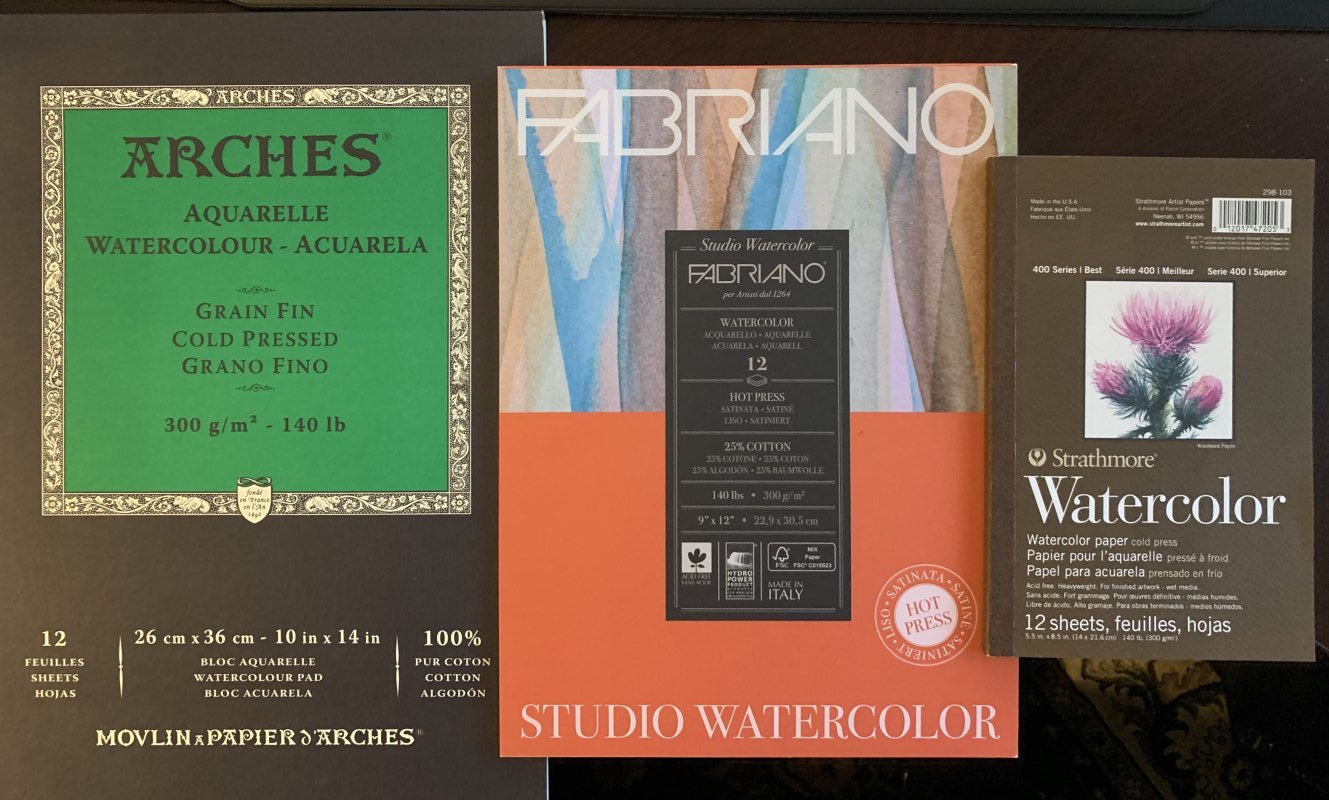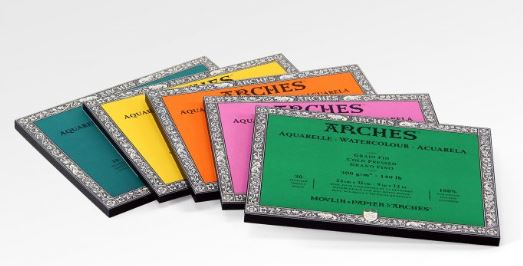Watercolor Paper
Watercolor paper is a special type of paper that has is soaked or coated in a “sizing” of gelatin or glue. The sizing allows the paper to readily absorb water while leaving the brilliant pigments of applied watercolor paints on the surface. It comes in three different types:
- Cold-press, which has a moderate texture.
- Hot-press which is very smooth.
- Rough, which has a more pronounced texture.
As your skill level grows, you may find yourself interested in trying the more exotic types of watercolor paper. There are handmade and mould-made papers in addition to the common machine-made papers. However, for beginners, a machine-made 100% cotton paper is a fine choice, and will work for most artistic goals.
Another point to note is that papers can differ in their acidic/alkaline levels, and if a paper is too acidic, it can ruin a painting over time. You may want to pay attention to this when purchasing paper. A neutral pH of 7.0 is preferred.
Watercolor Paper: Weight and Thickness
Paper also comes in different weights. Paper "weight" is a manufacturing reference to the thickness of the paper, and how that changes the weight of a standard ream (a stack of 500 sheets). The most common are 90-lb (pound) (a ream of 500 sheets weighs 90 pounds), 140-lb and the thicker 300-lb paper. Each of these papers will behave differently as paint is applied, as each absorbs water differently.
The most common watercolor paper generally used is 140-lb, cold-press paper, such as the Arches and Strathmore 400 in the picture below. There are also 140-lb hot press paper choices such as the Fabriano in the picture. Most paper manufacturers make all three weights, many different sizes and all three types.
 Arches, Fabriano, and Strathmore 400 watercolor paper
Arches, Fabriano, and Strathmore 400 watercolor paperPaper Sizes and Formats
You can buy watercolor paper in various sizes and formats. Loose watercolor paper sheets are sold in sizes such as 22” x 30”. These can be cut or torn down to any smaller size needed. There are larger single sheet sizes available and you can also buy paper in rolls.
Hobby stores such as Michael's or Hobby Lobby carry watercolor paper that has been precut into various sizes and bound into pads, although some stores do offer the large single sheets as well. Common pad sizes can go from 8x10" up to 16x20". There are also specialty card sizes such as 4x6" and 5x7", and a few more unusual sizes offered by some companies.
Pads are glued together on one edge. The artists tears out a sheet and then tapes or staples it down it to a supporting surface to use it. The pads in the picture above are examples of this type of format.
The pad is in contrast to “blocks” of paper. Watercolor blocks are glued together on all four edges. The idea of gluing all edges is to keep the paper from buckling while being used. (That's the idea, but in practice, it doesn't always work.)
When the painting is done, there’s a small opening in the glue on one side of the block into which you can slip a knife. This will allow you to lift the painting from the page below it to break it free. The disadvantage is that you have to finish a painting before you can use the next page.
Paper Composition and Brand
Watercolor paper is made of cotton rag, but the amount of cotton within the paper can vary. Cheaper papers may only be 45% cotton with the rest being wood pulp or other filler material. The result is that they will absorb water and paint differently than the 100% rag professional papers.
If you are just starting out in watercolor, be aware that painting failures might be the result of cheap paper, rather than your skill level.
Most professional artists work on the most expensive 100% cotton rag paper.
Okay then, which brand? There are many different brands of watercolor paper, and the question of which to buy is asked on many watercolor forums.
I've read the reviews. Let's cut to the conclusion...
Arches Aquarelle is often mentioned, and most of the professional artists in the US that I follow use this brand. The overall conclusion is that Arches Aquarelle 140-lb cold press paper is the preferred watercolor paper to buy when starting out as a watercolor artist.
Now, let's move on to how to use the paper...

Applying the Paper to a Supporting Surface
All watercolor paper will buckle when it gets wet, so the paper should be fastened to a working surface before paint is applied. The surface can be anything stiff enough to paint on. Some people use heavy cardboard, others use plexiglass, Masonite board or plywood.
Paper sizes smaller than a quarter sheet (11"x 15") can be taped down and/or stapled to an appropriate supporting surface. One of the more common surfaces for anchoring watercolor paper is called gator board, which is a foam core board specifically useful for stretching watercolor paper.
So, that's what I think is important about paper for the beginning artist. Check out this great blog post from Jacksons art in the UK which has a mind-boggling amount of information about watercolor paper and how it is made.
And Steve Mitchell over at The Mind of Watercolor Youtube channel has a great video on why you want to buy Arches over cheaper papers.